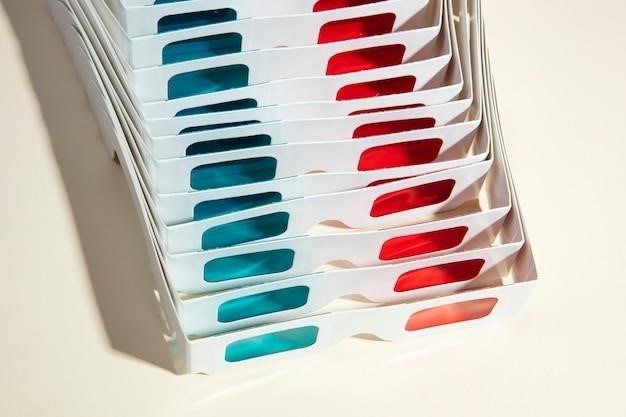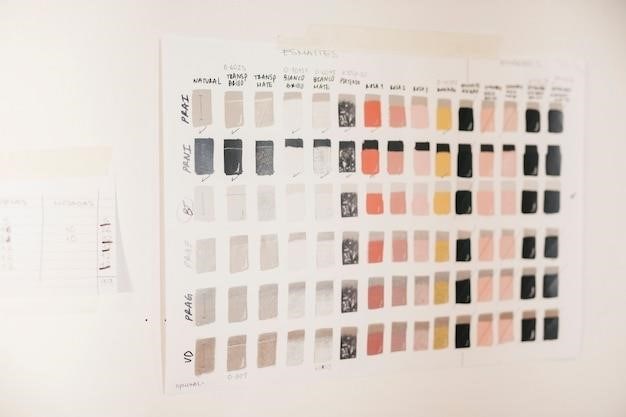VITA Classical Shade Guide⁚ A Comprehensive Overview
The VITA Classical Shade Guide, a cornerstone in dentistry for precise shade matching, offers sixteen natural shades (A1-D4) and additional bleached shades (0M1-0M3). Its user-friendly design simplifies shade selection, facilitating efficient communication between dentist and patient regarding desired tooth color and whitening outcomes. This guide ensures accuracy and consistency in restorative dentistry procedures.
Introduction to the VITA Classical Shade Guide
For over five decades, the VITA Classical Shade Guide has been a trusted tool in dental practices worldwide, providing a standardized system for precise shade determination in restorative dentistry. This renowned guide features a comprehensive range of sixteen natural tooth shades, meticulously organized from A1 to D4, encompassing variations in hue and chroma. Each shade represents a specific color found in natural teeth, enabling dentists to select the perfect match for restorations, ensuring a seamless and natural-looking result. The VITA Classical Shade Guide’s enduring popularity stems from its simplicity, reliability, and consistent color accuracy, making it an indispensable asset for both experienced professionals and those new to the field.
Beyond the core sixteen shades, the VITA Classical system has expanded to include a selection of bleached shades (0M1, 0M2, 0M3), mirroring the results achievable through professional teeth whitening procedures. This addition allows for effective pre- and post-treatment shade matching, facilitating clear communication with patients and precise monitoring of whitening progress. The integration of these bleached shades enhances the VITA Classical Shade Guide’s versatility and value in contemporary dental practice.
The 16 VITA Classical Shades (A1-D4)⁚ A Detailed Breakdown
The VITA Classical Shade Guide’s sixteen shades are systematically arranged to represent the natural spectrum of tooth colors. The system uses a letter-number combination, where the letter (A, B, C, D) indicates the hue, ranging from reddish-brownish (A) to reddish-grey (D), with B representing reddish-yellowish and C representing greyish shades. The number (1-4) denotes the chroma, or intensity of the color, with 1 being the lightest and 4 the darkest within each hue group. This systematic arrangement facilitates quick and accurate shade selection. For instance, A1 represents a light reddish-brown shade, while D4 signifies a dark reddish-grey shade. This detailed breakdown allows for precise matching of the restoration to the patient’s natural tooth color, resulting in aesthetically pleasing and natural-looking restorations.
Understanding the subtle variations within each hue and chroma level is crucial for achieving optimal results. The guide’s design allows for easy comparison and selection, minimizing the chance of mismatches. The logical progression of shades ensures a smooth transition between options, making it straightforward to find the most appropriate shade for each individual case. This precise organization is a key factor contributing to the guide’s long-standing success and reliability in the dental field.
VITA Bleached Shades⁚ Expanding Shade Selection
To address the growing demand for tooth whitening procedures, VITA introduced Bleached Shades as a complementary addition to the Classical Shade Guide. These shades, designated 0M1, 0M2, and 0M3, represent the spectrum of colors achievable through bleaching treatments. They are based on the VITA SYSTEM 3D-MASTER shade system, ensuring consistency and compatibility across different shade guides. The inclusion of these bleached shades significantly enhances the guide’s versatility. They allow dentists and patients to visualize the potential results of bleaching before treatment commences, facilitating realistic expectations and informed decision-making. This pre-treatment planning is invaluable for managing patient expectations and achieving optimal aesthetic outcomes.
Moreover, these shades are not just for pre-treatment planning; they also serve as valuable tools for monitoring progress during and after whitening procedures. By comparing the patient’s teeth to the Bleached Shades throughout the treatment, dentists can accurately assess the effectiveness of the bleaching process. This ensures the treatment achieves the desired level of whitening without causing unintended damage or discoloration. The availability of these additional shades ensures that the VITA Classical Shade Guide remains a comprehensive and adaptable tool for modern dental practices.

Using the VITA Classical Shade Guide⁚ A Step-by-Step Guide
Accurate shade selection is paramount for successful restorative dentistry. The VITA Classical Shade Guide simplifies this process with its intuitive design. Begin by ensuring optimal lighting conditions; natural daylight is preferred, minimizing artificial light sources that can distort color perception. Next, isolate the tooth to be matched, cleaning away any debris or surface stains. Directly compare the tooth to the shades within the guide, holding the guide at a slight angle to minimize shadowing effects. Consider the tooth’s overall color, paying attention to both hue (reddish, yellowish, grayish) and value (lightness or darkness);
For a comprehensive evaluation, compare the shade in multiple lighting conditions and from different angles to account for subtle variations in color. Involve the patient in the shade selection process to ensure their preferences are considered and to establish clear communication. Once the most accurate shade match is determined, carefully record the shade designation for future reference. This meticulous approach ensures that the final restoration perfectly complements the patient’s natural dentition, achieving seamless aesthetics and a harmonious smile.
Accuracy and Precision in Shade Matching
Achieving precise shade matching is crucial for aesthetically pleasing and natural-looking restorations. The VITA Classical Shade Guide’s standardized color samples minimize subjective interpretation, promoting consistent and reliable results across different clinicians and settings. However, even with a standardized guide, several factors can influence shade perception. Lighting conditions significantly impact color appearance; therefore, consistent, natural light is essential. The observer’s individual perception of color can also introduce variability, highlighting the importance of careful observation and comparison.
Surface texture and moisture content of both the natural tooth and the shade guide can affect the reflection and absorption of light, potentially leading to inaccuracies. To mitigate these effects, ensure the tooth surface is clean and dry before comparison. Furthermore, comparing the shade at multiple angles and under different lighting conditions can help identify subtle variations and ensure a more accurate match. By employing these techniques and using the VITA Classical Shade Guide, dentists can achieve exceptional accuracy and precision in shade selection for superior restorative outcomes.
Comparing VITA Classical to Other Shade Guides
While the VITA Classical Shade Guide is a widely recognized and respected standard, other shade guides exist, each with its own strengths and limitations. Direct comparisons often reveal subtle differences in color representation, reflecting variations in manufacturing processes and underlying colorimetric principles. Some systems offer a broader range of shades or incorporate additional parameters beyond basic hue, chroma, and value, aiming for greater precision in capturing the subtle nuances of natural tooth color. The choice of shade guide often depends on individual preferences, clinical experience, and the specific needs of a particular case.
Factors such as the guide’s physical format, ease of use, and availability of supplementary resources, such as digital shade-taking systems compatible with the guide, also influence the selection process. Understanding the unique characteristics of each system, including potential discrepancies between them, allows clinicians to make informed decisions and choose the guide that best suits their workflow and ensures the highest level of accuracy in shade selection for their patients. Cross-referencing charts or conversion tables can be helpful when transitioning between different shade guides.
The VITA Classical Shade Guide in Practice⁚ Case Studies
Consider a patient requiring a porcelain veneer. Using the VITA Classical Shade Guide, the dentist identifies the patient’s natural tooth shade as A2. The chosen veneer is fabricated to match this shade, ensuring a natural-looking restoration. In another case, a patient undergoing tooth whitening desires a preview of potential outcomes. The bleached shades (0M1-0M3) within the guide, allow for a discussion of realistic expectations and monitor progress during the bleaching process. Accurate shade matching, facilitated by the VITA Classical guide, is crucial for achieving seamless integration of restorations with surrounding natural teeth, leading to improved esthetic results.
Furthermore, a situation involving a full-mouth reconstruction benefits significantly from the guide’s standardized shades. The consistent color selection simplifies the process of achieving harmony across multiple restorations. This minimizes discrepancies and ensures a cohesive final result. These examples illustrate the versatility of the VITA Classical Shade Guide in diverse clinical scenarios, ultimately contributing to improved patient satisfaction through enhanced aesthetics and predictable outcomes in restorative and cosmetic dentistry.
Benefits of Using Standardized Shade Guides
Standardized shade guides, like the VITA Classical Shade Guide, offer several key advantages in dental practice. Firstly, they provide a consistent and universally understood language for communication between dentists, technicians, and patients regarding tooth color. This eliminates ambiguity and ensures everyone is on the same page regarding shade selection. Secondly, using a standardized guide improves the accuracy and predictability of restorative procedures. By selecting shades from a pre-defined system, dentists can minimize discrepancies between the shade of the restoration and the patient’s natural teeth, leading to improved aesthetic outcomes.
Thirdly, these guides streamline the workflow. The readily available shade tabs facilitate quick and efficient shade selection, saving both time and effort during the consultation and treatment phases. Furthermore, using a standardized system simplifies the process of ordering materials and communicating specifications to dental laboratories. The improved efficiency translates to cost savings and enhanced patient satisfaction. In essence, standardized shade guides such as the VITA Classical system enhance communication, improve accuracy, and streamline the overall dental treatment process.
Maintaining and Caring for Your VITA Classical Shade Guide
Proper maintenance ensures the longevity and accuracy of your VITA Classical Shade Guide. Avoid exposing the guide to excessive heat or direct sunlight, as this can affect the shade integrity over time. Keep the guide clean by gently wiping it with a soft, damp cloth. Avoid using abrasive cleaners or harsh chemicals, as these can damage the surface and alter the appearance of the shades. Store the guide in its protective case when not in use to prevent scratches and dust accumulation. Regularly inspect the guide for any signs of wear or damage. If any significant damage occurs, contact the manufacturer or your dental supplier for replacement or repair.
For the bleached shades, which are often sold separately, follow the same cleaning and storage guidelines. Handle the shade tabs with care to prevent chipping or breakage. If a shade tab becomes damaged, it’s crucial to replace it to maintain the accuracy of the shade matching process. By following these simple maintenance procedures, you can safeguard the accuracy and usefulness of your VITA Classical Shade Guide, ensuring reliable shade selection for years to come. Proper care preserves the investment in this essential dental tool.

The Future of Shade Selection in Dentistry
The future of shade selection in dentistry points towards increased integration of digital technologies. While physical shade guides like the VITA Classical remain valuable tools, advancements in digital imaging and software are transforming the process. Intraoral cameras and spectrophotometers offer objective shade readings, minimizing subjective interpretation and enhancing consistency. These digital tools, combined with sophisticated software, can generate precise shade matches, reducing reliance on traditional visual comparison. Artificial intelligence (AI) is also poised to play a significant role, potentially automating shade analysis and improving the accuracy of shade matching algorithms. This evolution aims to streamline workflows, improve efficiency, and ultimately deliver more precise and predictable restorative outcomes for patients.
Furthermore, research into the perception of color and the development of new shade systems could lead to more comprehensive and nuanced shade guides in the future. The integration of virtual reality (VR) and augmented reality (AR) technologies might also offer innovative ways to visualize and select tooth shades, providing patients with a more interactive and engaging experience. The goal is to create a more seamless and intuitive shade selection process, leading to enhanced patient satisfaction and improved clinical outcomes.